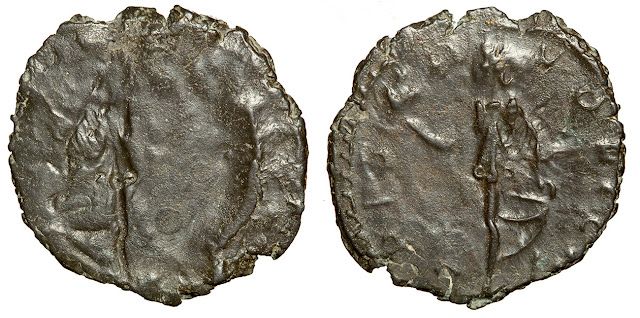 |
| Billon antoninianus of Claudius II Gothicus, 268-270 CE. |
I bought them because they hold information. You can visualise Roman mints of this era as being very busy and not very discriminating. The dies they made and used were roughly figured and very stylised. They didn't filter out mistakes; those went into circulation along with the good coins.
There might have been up to four people working with each die pair. One would place the blank on the bottom die, which might be held by another worker or maybe fixed in place. This die would have the head image hollowed out. Another would place the top die with the reverse image on top of the blank, and yet another would hit it with a hammer, at least once, maybe more than once.
What's happened with the top coin is that instead of the struck coin being cleared out of the way, it has flipped over and has still been half in the die when it was hit again. So, overlying the head image is part of the reverse design, and on top of the reverse, part of the head. You can see a sideways image of the crown.
Double strikes are not rare, but they are usually a just a sideways shift of the coin between hits, so that two similar images are superimposed. This one is a bit more interesting.
 |
| Billon Antoninianus of Tetricus I or Tetricus II, 271-274 CE. |
These are not the only kinds of mint errors. It is also possible to have a die clash, where there has been no blank between the dies when they have been struck. This damages the dies themselves, and all subsequent coins made with those dies look wrong. There's a good example on one of Doug Smith's pages here: Brockages and Clashed Dies which also shows some nice brockages.
You can tell a coin is a die clash if you can find more than one of exactly the same error, as Doug's page demonstrates. In fact, I have one of the very same type as his:
 |
| Silver denarius of Julia Domna, "Emesa" mint, 194 CE. |
No comments:
Post a Comment